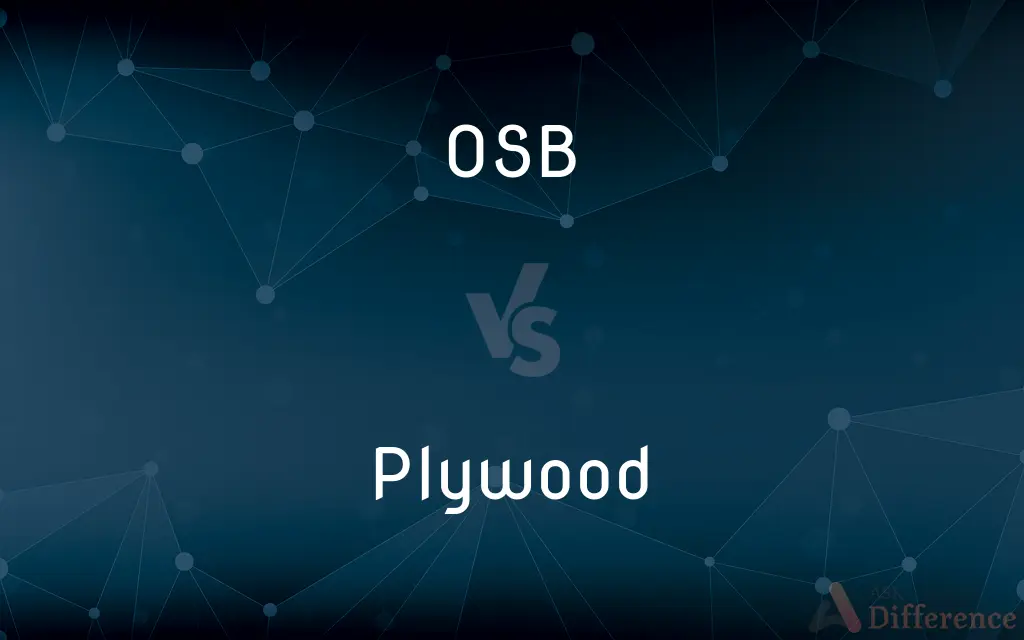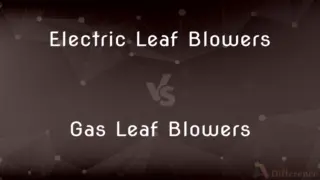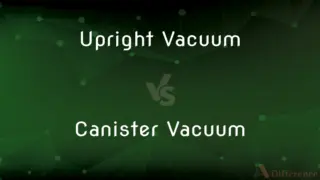OSB vs. Plywood — What's the Difference?
By Tayyaba Rehman & Fiza Rafique — Published on February 15, 2024
OSB (Oriented Strand Board) is made of pressed wood strands in specific orientations, often used in sheathing and flooring. Plywood consists of thin wood layers glued together, known for strength and versatility in construction.

Difference Between OSB and Plywood
Table of Contents
ADVERTISEMENT
Key Differences
OSB and Plywood are two types of engineered wood products commonly used in construction and DIY projects. OSB is manufactured by combining wood strands with adhesives, then compressing them under high pressure and temperature. This process results in a strong and dense board, with strands oriented in layers for increased strength. OSB is particularly valued for its consistency and cost-effectiveness, making it a popular choice for sheathing in walls, flooring, and roof decking.
Plywood, on the other hand, is made by gluing together thin layers of wood veneers, with each layer's grain running perpendicular to the adjacent layers. This cross-graining technique enhances the plywood's strength, reduces expansion and shrinkage, and provides resistance to splitting. Plywood is known for its durability and flexibility, used in a wide range of applications from furniture making to construction, where it serves as a dependable material for floors, walls, and roofs.
While both materials offer structural integrity and are used in similar applications, there are distinct differences. OSB tends to be more cost-effective than plywood, making it a preferred option for those on a budget. However, plywood often performs better in environments where moisture is a concern, as it can dry more quickly and is less prone to swelling compared to OSB.
The choice between OSB and Plywood typically depends on the specific requirements of the project, including budget constraints, exposure to moisture, and the need for structural strength. Plywood's smoother surface also makes it a preferred choice for projects where appearance is important, such as in cabinet or furniture making.
In summary, both OSB and Plywood are essential materials in construction and woodworking, each with its own set of advantages. OSB offers cost efficiency and uniform strength, while Plywood provides superior moisture resistance and strength due to its layered structure.
ADVERTISEMENT
Comparison Chart
Material Composition
Wood strands and adhesives
Thin wood veneers glued together
Strength
Uniform strength across the board
High strength, especially along the edges
Moisture Resistance
Less resistant, can swell
Better resistance, dries faster
Cost
Generally less expensive
More expensive
Applications
Sheathing, subflooring, roofing
Furniture, construction, subflooring
Compare with Definitions
OSB
Commonly used in sheathing and roofing.
Our contractor recommended OSB for the roof decking.
Plywood
Constructed from multiple layers of wood veneer.
Plywood's layers give it the strength needed for the flooring.
OSB
Less resistant to moisture than plywood.
We avoided using OSB in areas prone to moisture.
Plywood
Used in a wide range of woodworking projects.
Plywood is versatile enough for both furniture and construction.
OSB
A board made from compressed wood strands.
We used OSB for the wall sheathing in our new house.
Plywood
Known for its durability and versatility.
We chose plywood for the cabinets due to its smooth finish.
OSB
Cost-effective material for construction.
Choosing OSB helped us stay within our construction budget.
Plywood
Better moisture resistance compared to OSB.
Plywood was the clear choice for the bathroom subfloor.
OSB
Offers uniform strength and stability.
OSB provides the structural integrity we need for the project.
Plywood
More expensive but offers better quality.
The higher cost of plywood is justified by its superior performance.
Plywood
A structural material made of layers of wood glued together, usually with the grains of adjoining layers at right angles to each other.
Plywood
(uncountable) Construction material supplied in sheets, and made of three or more layers of wood veneer glued together, laid up with alternating layers having their grain perpendicular to each other.
After the hurricane there was a severe regional shortage of plywood, especially exterior plywood.
Plywood
(countable) A specific grade or type of this construction material.
We stock exterior plywoods, interior plywoods, and furniture plywoods.
Plywood
(transitive) To fit or block up with plywood.
Plywood
A laminate made of thin layers of wood
Common Curiosities
Which is more environmentally friendly, OSB or Plywood?
Both have environmental considerations; OSB uses smaller, fast-growing trees, while plywood manufacturing may involve larger, older trees.
Which is heavier, OSB or Plywood?
OSB is generally heavier than an equivalent thickness of plywood.
How should OSB and Plywood be stored?
Store flat and off the ground, covered to protect from moisture.
Can both OSB and Plywood be used for exterior projects?
Yes, but both should be properly sealed and preferably used in areas not exposed to direct moisture.
Are OSB and Plywood waterproof?
Neither is waterproof, but both can be water-resistant to some degree.
Can I use OSB or Plywood for a subfloor?
Yes, both are commonly used for subflooring, with the choice depending on specific project needs.
Is it possible to use OSB for furniture making?
While possible, plywood is usually preferred for its smoother surface.
Do I need special tools to cut OSB and Plywood?
No special tools are required, but a circular saw or table saw can provide clean cuts.
How do OSB and Plywood react to fire?
Both are combustible but can be treated with fire retardants for improved resistance.
Can I paint over OSB and Plywood?
Yes, both can be painted, but the surface of OSB may require more preparation.
Can I use Plywood instead of OSB for roofing?
Yes, plywood can be used for roofing, often preferred for its moisture resistance.
What are the standard sizes for OSB and Plywood?
Standard sizes include 4x8 feet sheets, with various thicknesses available.
How long do OSB and Plywood last?
Both can last decades when properly installed and maintained.
Which is better for sound insulation, OSB or Plywood?
Both provide similar sound insulation properties.
Which should I choose for a DIY project, OSB or Plywood?
Consider the project's requirements, including strength, appearance, and cost.
Share Your Discovery

Previous Comparison
Electric Leaf Blowers vs. Gas Leaf Blowers
Next Comparison
Upright Vacuum vs. Canister VacuumAuthor Spotlight
Written by
Tayyaba RehmanTayyaba Rehman is a distinguished writer, currently serving as a primary contributor to askdifference.com. As a researcher in semantics and etymology, Tayyaba's passion for the complexity of languages and their distinctions has found a perfect home on the platform. Tayyaba delves into the intricacies of language, distinguishing between commonly confused words and phrases, thereby providing clarity for readers worldwide.
Co-written by
Fiza RafiqueFiza Rafique is a skilled content writer at AskDifference.com, where she meticulously refines and enhances written pieces. Drawing from her vast editorial expertise, Fiza ensures clarity, accuracy, and precision in every article. Passionate about language, she continually seeks to elevate the quality of content for readers worldwide.
















































